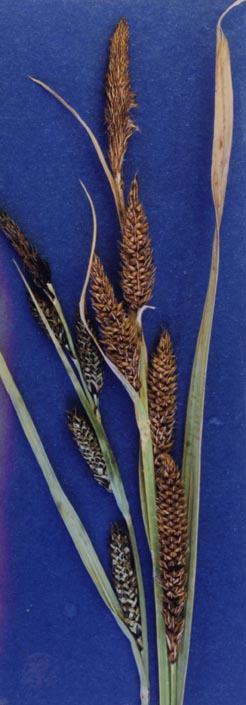Nebraska Sedge

Common Name(s):
Nebraska Sedge
Scientific Name:
Carex nebrascensis Dewey
Scientific Name Synonyms:
None known
Symbol:
CANE2
Description:
Life Span: Perennial
Origin: Native
Season: Cool
Growth Characteristics: A loosely to densely tufted sedge, 8 to 36 inches tall, with numerous rhizomes. Rhizomes are stout, brown or straw-colored, and scaly. Stems triangular, not hollow. Reproduces from seed and rhizomes
Seedhead: Terminal spikes are male and relatively narrow. The lateral spikes are female, 1/3 to 1 ½ inches long, with purple to brownish-black scales. The lowest spike is subtended by a leafy bract as long as or longer than the inflorescence.
Leaves: Alternate, elongated, shorter or longer than the stem, up to ½ inch wide, smooth or sometimes roughened along the edges. Leaves are flat, but have a v-shaped trough along the midvein. Leaves are often bluish colored; sheaths are yellow-brown.
Ecological Adaptions:
Nebraska sedge occurs from the lower valleys to the spruce-fir zone, its determining factor being water rather than elevation. It is one of the most common sedges in sagebrush areas. Nebraska sedge reproduces by rhizomes and seed production, although seedling establishment is rare. Shoots from rhizomes are produced throughout the growing season and into late fall. Due to the habitat in which it occurs, Nebraska sedge can be damaged through excessive overgrazing and the trampling associated with it on wet soils.
Soils: It occurs on clay loam soils with adequate moisture.
Associated Species: Associated species include wirerush, timothy, water sedge, and other native sedges. In disturbed areas, it can be found with Kentucky bluegrass and redtop.
Uses and Management:
Nebraska sedge is a valuable forage species, highly palatable to cattle, horses, and elk, and moderately palatable to sheep and mule deer. Because it is a common riparian species, Nebraska sedge is an important indicator of the effects of grazing in riparian areas. Heavy, repeated summer and fall grazing, or season-long grazing, will result in Nebraska sedge being replaced by more grazing resistant species such as Kentucky bluegrass.
Nebraska sedge forms a dense, deep root system which provides excellent resistance to soil compaction and erosion. It will stabilize overhanging banks along streams, providing fish habitat.
Native Americans used the fibers for mats and bedding and ate the rootstocks.

